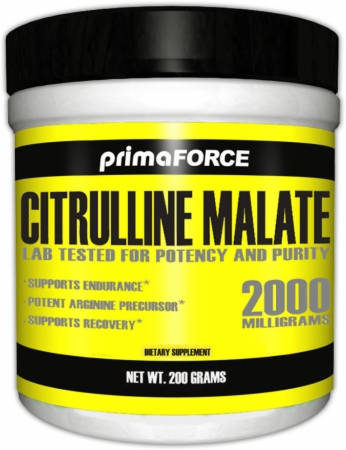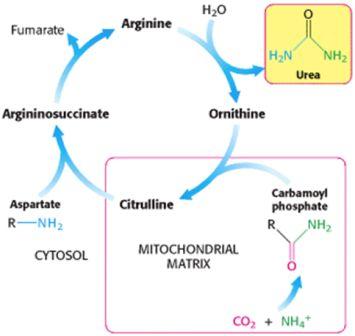
Citrulline Malate is a dietary supplement and amino acid precursor to arginine that has been getting more and more press in the area of enhancing performance. The fact that it is a precursor to arginine doesn’t mean that I’m going to start talking about mind blowing pumps and nitric oxide production (okay I might a little, but it won’t be in the context that you think) – So please don’t stop reading.
Below is the compulsory biochemical pathway picture that shows the role of citrulline in the urea cycle. This will become important in a little bit.

Increasing Performance
There are a couple different ways that you can go about increasing performance. Get more muscle or make the muscle that you have work better. The later can lead to the former, making it an area that is worth focusing on.
There are different supplements available that can help your muscles work better. Creatine supplementation aids in the rapid replenishment of ATP allowing for more work to be done. Beta-alanine supplementation, leads to increase intramuscular carnosine stores. Carnosine can be used as a pH buffer by working muscles, preventing a decrease in intramuscular pH which prevents the tripping of the ‘fatigue’ switch by your muscles. This allows you to keep banging out reps without ‘feeling the burn’ as much as you normally would.
Citrillune Malate (CM) may be able to increase performance by two similar mechanisms –
- Increasing energy delivery and
- The clearance of metabolic waste which when left hanging around degrades performance.
How does this work? Pérez-Guisado et al (1) hypothesized that CM fights fatigue through accelerating the clearance of ammonium (NH4+). Asserting that supplementation with CM drives the urea cycle by “accelerating the rotation of the cycle.” Callis et al (2) reported a pH buffering effect of CM that supports Pérez-Guisado et al’s hypothesis about CM removing excess ammonium from our system.
CM supplementation also increases blood arginine levels (better than actually supplementing with arginine) and if this then leads to an increase in NO production (I’m taking an academic/biochemical leap here)…The increased blood flow which results due to increase NO would also serve to clear metabolic waste and flush more oxygen and nutrients towards working muscles allowing for more muscular work to occur. This would present itself to you (the user) as a decrease in fatigue as you’d be able to do more work.
Let’s take it one step further and look at Malate. Malate is a TCA cycle intermediate which comes coupled to citrulline as more of an afterthought than an additional fatigue fighting factor. But, if supplements were 1990’s NBA basketball and citrulline was Michael Jordan, malate would be Scottie Pippen – often overlooked but required for all those championships.
Malate is the perfect complement to citrulline as Pérez-Guisado et al points out
“Malate…is capable of behaving as a metabolic shuttle between cytoplasm and mitochondria, enables bypassing of blockade of the oxidative pathway induced by ammonia, and hence limits accumulation of lactic acid by reorienting it toward pyruvate genesis and its aerobic utilization or neoglucogenesis. Accumulation of lactate and resultant acidosis leads secondarily to the blockage of glycolysis”
So citrulline and malate are fighting fatigue via two different yet complimentary mechanisms.
Citrulline Malate in Action
I’ve mentioned Pérez-Guisado et al a couple times now so let’s look at the study they conducted with CM. Here’s the quick outline of how the study was set up.
- Participants drank a beverages containing 8 grams of CM or placebo
- 4 sets of bench press using 80% RM – AMRAP with 1 minute rest between sets
- 4 sets incline bench press using same weight as bench press – AMRAP with 1 minute rest between sets
- 4 sets of DB flies using 60% bench press RM – AMRAP with 1 minute rest between sets.
- 4 sets of bench pressing using 80% RM – AMRAP
The study was a crossover design meaning that if you got the placebo drink the first time, the second time you went through the protocol (1 week later), you got the CM drink.
After the 3th set of bench press, the CM enhanced workouts were yielding a significant increase in reps per set (ranging from ½ rep more to 1 rep more). By the last set (16th set) of the CM enhanced workout was yielding a 50% increase in reps (1 ½ to 2 ¼ more reps). The trend was that as the workout progressed, CM had more of an effect (Note: The researchers didn’t do a ‘trend’ analysis; that was just my observation). The researchers also looked at rating of muscle soreness at both 24 and 48 hours. The addition of CM to the chest workout yielded less muscle soreness at both time points (~40% less sore).
Bringing it Home
The bottom line on CM goes like this: we need more research as there isn’t a huge body of research supporting the use of CM but there just isn’t a lot of research on it in general.
As you can probably imagine, funding CM studies isn’t on the National Institute of Health’s priority list. Biochemically, the proposed mechanism behind the fatigue fighting efforts of CM are sound and in-line with the limited data we have.
Plus did I mention that it is CHEAP? It isn’t creatine cheap, but 200 grams of CM is less than $20. At 8 grams per use (which is on the high side regarding dosage), you’re looking at only 79 cents per serving.
That is a tiny cost for the upside of a 40% decrease in muscle soreness (so you can train harder) and an 18% increase in reps. When it comes down to the wire, you want to be the guy that has more gas left in the tank and CM is a simple way to make sure that happens.
References
1. Pérez-Guisado J, Jakeman PM. CITRULLINE MALATE ENHANCES ATHLETIC ANAEROBIC PERFORMANCE AND RELIEVES MUSCLE SORENESS. Journal of Strength and Conditioning Research 2010;24:1215-1215-1222.
2. Callis A. Activity of citrulline malate on acid-base balance and blood ammonia and amino acid levels. Study in the animal and in man. Arzneimittel-Forschung 1991;41:660-663.

Comments